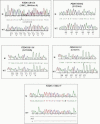FZD6 is a novel gene for human neural tube defects
- PMID: 22045688
- PMCID: PMC3482927
- DOI: 10.1002/humu.21643
FZD6 is a novel gene for human neural tube defects
Abstract
Neural tube defects (NTDs) are severe malformations of the central nervous system, affecting 1 of 1,000 live births. Mouse models were instrumental in defining the signaling pathways defective in NTDs, including the planar cell polarity (PCP), also called noncanonical Frizzled/Disheveled pathway. Based on the highly penetrant occurrence of NTDs in double Fzd3/Fzd6(-/-) mutant mice, we investigated the role of the human orthologues, FZD3 and FZD6, by resequencing a cohort of 473 NTDs patients and 639 ethnically matched controls. While we could not demonstrate a significant contribution of FZD3 gene, we identified five rare FZD6 variants that were absent in all controls and predicted to have a functional effect by computational analysis: one de novo frameshift mutation (c.1843_1844insA), three missense changes (p.Arg405Gln, p.Arg511Cys p.Arg511His), and one substitution (c.*20C>T) affecting the 3'-untranslated region (UTR) of the gene. The overall rate of predicted deleterious variants of FZD6 was 5.1-fold higher in cases compared to controls, resulting in a significantly increased NTDs mutation burden. This study demonstrates that rare nonsynonymous variants in FZD6 may contribute to NTDs in humans and enlarges the spectrum of mutations that link PCP pathway to NTDs.
© 2011 Wiley Periodicals, Inc.
Figures


References
-
- Ambros V. The functions of animal microRNAs. Nature. 2004;431:350–355. - PubMed
-
- Barrow JR. Wnt/PCP signaling: a veritable polar star in establishing patterns of polarity in embryonic tissues. Semin Cell Dev Biol. 2006;17:185–193. - PubMed
-
- Bartel DP. MicroRNAs: genomics, biogenesis, mechanism, and function. Cell. 2004;116:281–297. - PubMed
-
- Botto LD, Moore CA, Khoury MJ, Erickson JD. Neural-tube defects. N Engl J Med. 1999;341:1509–1519. - PubMed
-
- Cong F, Schweizer L, Varmus H. Wnt signals across the plasma membrane to activate the beta-catenin pathway by forming oligomers containing its receptors, Frizzled and LRP. Development. 2004;131:5103–5115. - PubMed
Publication types
MeSH terms
Substances
Grants and funding
LinkOut - more resources
Full Text Sources
Medical
Molecular Biology Databases

